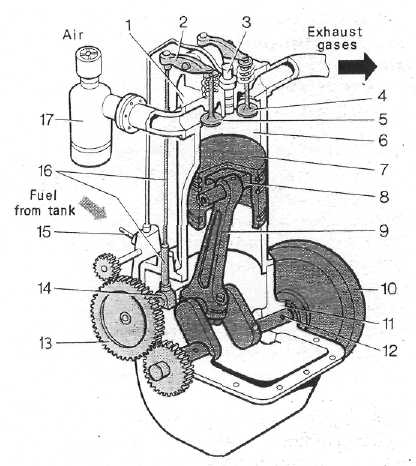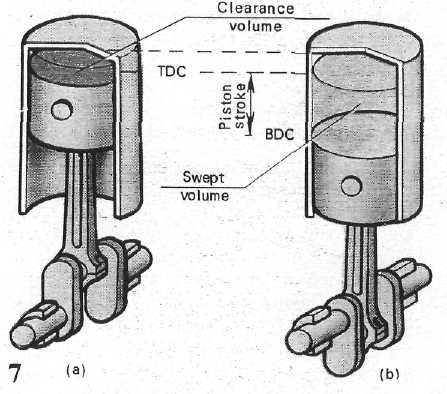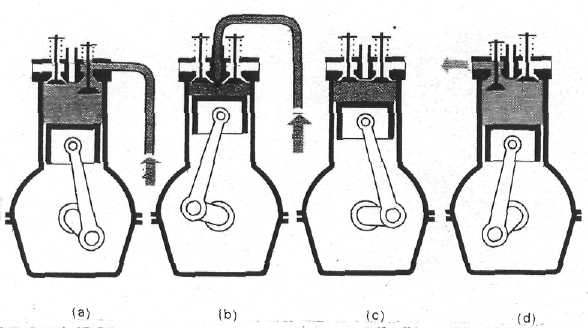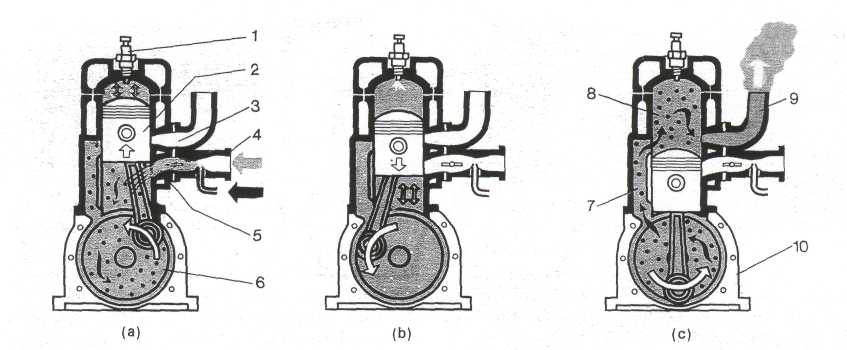
Chapter 3
Fundamentals of Engine Operation
and Construction
3.1. Basic Notions and Definitions
CLASSIFICATION OF ENGINES.
Modern farm tractors and automobiles are powered by piston-type internal combustion engines. An internal combustion engine is one in which the thermal energy supplied by a burning fuel is directly transformed into mechanical energy by the controlled combustion of the fuel in an enclosed cylinder behind a piston. Such engines are classified according to the following basic features:
by the method of mixing fuel and air: engines with external mixing – carburetor engines and gas engines; engines with internal mixing – diesel engines;
by the method of ignition of air-fuel mixture: spark ignition engines – carburetor engines and gas engines; compression ignition (self-ignition) engines – diesel engines;
by the number of piston strokes in one complete cycle of operations: four-stroke engines and two-stroke engines;
by the kind of fuel used: gasoline (petrol) engines, gas engines, and diesel engines;
by the cooling method: liquid-cooled engines and air-cooled engines;
by the number of cylinders: single cylinder engines and multicylinder engines (double-cylinder, four-cylinder, six-cylinder, eight-cylinder, and twelve-cylinder engines);
by the cylinder arrangement: single-row engines and double-row engines including V-type ones in which the two rows of cylinders are arranged at an angle to each other.
BASIC NOTIONS.
It takes oxygen to burn the fuel; therefore the latter is mixed with air. A mixture of atomized fuel and air in certain proportions by weight is called air-fuel mixture. The air-fuel mixture entering a cylinder of a running engine intermingles with unscavenged exhaust gases and thus forms what is known as the combustible charge. Engines using a special device – carburetor – to mix fuel with air are referred to as carburetor engines. In such engines, the air-fuel mixture is ignited by a spark. In diesel engines, the air-fuel mixture forms inside the cylinder and is self-ignited by the heat of compressed air. Carburetor engines are used mainly on light and medium trucks and cars and also on tractors where they serve to start the main engines. The main engines powering modern tractors and heavy trucks are of the diesel type. Referring to the simplified diagram of Fig. 1, consider the operation of the diesel engine. Piston 7 is placed inside cylinder 6. The piston is attached to crankshaft 12 through the intermediary of connecting rod 9. If the piston is moved up and down in the cylinder, this up-and-down, or reciprocating, motion of the piston is changed into the rotary motion of the crankshaft by the connecting rod and the crank of the shaft. Flywheel 10 fastened to the rear end of the crankshaft serves to make the shaft revolve uniformly when the engine is running. The cylinder is tightly closed at the top by cylinder head 1 housing two valves. Intake valve 5 admits air into the cylinder and exhaust valve 4 lets the burnt gases out. The valves are held closed by valve springs and are made to open by means of rocker arms 2 which are actuated by camshaft 14 through intermediate components (valve lifters and push-rods). The camshaft and the fuel injection pump shaft are driven by the crankshaft through gears 13. The fuel supplied by the fuel injection pump is injected into the cylinder through fuel injector 3.

Fig.1. Schematic diagram of a single-cylinder diesel engine
1 - cylinder head; 10 - flywheel;
2 - rocker arm; 11 - crankcase;
3 - fuel injector; 12 - crankshaft;
4 - exhaust valve; 13 - camshaft timing gear;
5 - intake valve; 14 - camshaft;
6 - cylinder; 15 - fuel injection pump;
7 - piston; 16 - valve lifter (tappet) and push-rod;
8 - piston pin; 17 - air cleaner
9 - connecting rod;
piston
at TDC;
piston
at BDC
Fig.2. Piston positions
at dead centers
The carburetor engine differs from the single-cylinder diesel engine shown in Fig. 1 in that the intake port closed by valve 5 serves to admit air-fuel mixture into the cylinder and a spark plug takes the place of the fuel injector in the cylinder head.
BASIC DEFINITIONS.
The piston, while reciprocating inside the cylinder, can occupy two extreme positions (Fig. 7). The uppermost position of the piston is termed the top dead center (TDC), while the lowermost position is referred to as the bottom dead center (BDC). The distance travelled by the piston from one dead center to the other is called the piston stroke. During one piston stroke the crankshaft rotates half a turn.
The space between the cylinder head and the piston at the top dead center is known as the combustion, or compression, chamber and the volume of this space is referred to as the clearance volume. The volume displaced by the piston as it moves from the bottom dead center to the top dead center is termed the displacement, also known as the swept, or stroke, volume.
The displacement of an engine cylinder is measured in liters. The displacement of all the cylinders of an engine is termed the engine displacement, or capacity. It is measured in cubic centimeters in small-displacement (up to 11) engines and in liters in large-displacement ones.
The total volume enclosed above the piston at the bottom dead center, i.e., the clearance volume plus swept volume, is called the air volume. The number showing how many times the clearance volume is the air volume, i.e., the ratio between the air volume and clearance volume, is known as the compression ratio. In modern carburetor engines, the compression ratio ranges from 6 (6:1) to 9 (9:1), reaching 15 (15:1) to 20 (20:1) in diesel engines.
A number of events occur in the cylinder of a running engine. First the cylinder is filled with an air-fuel mixture or air. Then the mixture or air is compressed. After igniting, the mixture of fuel and air burns and the gases formed as a result expand, push on the piston, and make it move, thus performing mechanical work. Then the burnt gases are purged from the cylinder. The above events are continuously repeated in a definite sequence all the time the engine is running and constitute the working cycle, or the cycle of operations, of the engine.
3.2. Engine Cycles
An event (a part of the engine cycle) that occurs in the engine cylinder during one piston travel is called a stroke. The engine which completes its working cycle in four strokes of the piston is known as the four-stroke-cycle, or simply four-stroke or four-cycle, engine.
WORKING CYCLE OF THE FOUR-STROKE DIESEL ENGINE.
Let us consider the sequence of events occurring in one of the cylinders of the running engine.
1st STROKE – INTAKE (Fig. 3a)
The piston is moved by the crankshaft and connecting rod downwards and, acting like a pump piston, it produces a vacuum in the cylinder. Fresh air is taken into the cylinder through the open intake valve, as a result of the pressure differential between the cylinder and atmospheric air. The exhaust valve is closed. At the end of the intake stroke, the intake valve closes. The pressure in the cylinder at the end of the intake stroke comes to an average of 0.08 to 0.095 MPa and the air temperature, 30 to 50°C.
2nd STROKE – COMPRESSION (Fig. 3b)
The crankshaft continues to rotate, so the piston, after passing BDC at the end of the intake stroke, starts moving upwards. Since both the intake and the exhaust valves are closed, the piston compresses the air in the cylinder. As the air is compressed, its temperature goes up. The compression ratio of the diesel engine being fairly high, the pressure in the cylinder rises up to 4 MPa and the air gets heated up to 600°C. As the piston nears TDC at the end of the compression stroke, a charge of finely atomized diesel fuel is injected into the cylinder through the fuel injector.
3rd STROKE – POWER, or expansion (Fig. 3c)
On coming into contact with the hot compressed air in the cylinder, fine fuel particles are self-ignited. The injection and burning of fuel go on for some time after the piston has passed TDC at the beginning of the power stroke. Because of a delay in the self-ignition of fuel, it burns mainly during this piston stroke. During the power stroke, both valves are closed. The temperature of combustion gases reaches 2000°C and the pressure in the cylinder increases up to 8 MPa. The high pressure of expanding gases pushes the piston downward. The piston transmits this push through the connecting rod to the crankshaft, making the latter perform mechanical work.
4th STROKE – EXHAUST (Fig. 3d)
As the piston reaches BDC on the power stroke, the exhaust valve opens to release the burnt gases under an excessive pressure. The piston then moves upwards again and pushes all of the exhaust gas from the cylinder. Finally, as the piston reaches TDC on the exhaust stroke, the exhaust valve closes and the intake valve opens. The piston then moves downwards once more on another intake stroke, and the cycle of events in the cylinder is then repeated.

Fig.3. Illustrating the operation of a single-cylinder four-stroke engine
(a) the first (intake) stroke;
(b) the second (compression) stroke;
(c) the third (power)stroke;
(d) the fourth (exhaust) stroke
Before the engine has fired, the crankshaft is rotated by means of an external power source, e.g., an electrical starter motor or a starting engine, since energy is necessarily required to perform the initial intake and compression strokes.
WORKING CYCLE OF THE FOUR-STROKE
CARBURETTOR ENGINE.
As distinct from the diesel engine, in the carburetor engine, fuel and air enter the cylinder in the form of an air-fuel mixture prepared by the carburetor.
Each of the strokes in the working cycle of the four-stroke carburetor engine, as in the diesel engine, is characterized by the position of the valves and the direction of the piston travel. The cycle of operations of the four-stroke carburetor engine occurs as follows.
intake
The piston moves downwards. The intake valve is open. As a result of a vacuum produced by the downward movement of the piston, the air-fuel mixture prepared by the carburetor enters the cylinder through the open intake port and, intermingling with the unscavenged exhaust gases, forms the combustible charge.
compression
The piston moves upwards. Both the intake and the exhaust valves are closed. The volume above the piston diminishes and the combustible charge is compressed, which facilitates the evaporation of gasoline and mixing of gasoline vapor with air. By the end of the compression stroke, the pressure in the cylinder reaches 1 to 1.2 MPa and the temperature, 350 to 400°C.
POWER – burning of fuel and expansion of combustion gases
Both valves are closed. At the end of the compression stroke, the combustible charge is ignited by a spark. The piston moves down from TDC to BDC under the pressure of expanding combustion gases. The pressure of the gases reaches 2.5 to 4 MPa and their temperature, 2000°C.
exhaust
The piston moves upwards. The exhaust valve is open. The spent exhaust gases leave the cylinder through the exhaust port.
Diesel engines are more economical than their carburetor counterparts. As a result of their higher compression ratio, the diesel engines burn 25% less fuel (per unit work done).
Diesel engines operate on heavy fuels that present less fire hazard in handling.
The diesels, however, feature some disadvantages:
they are more bulky, for the high pressure of combustion gases in the cylinder requires stronger engine components; hey are more difficult to start, especially in cold weather.
WORKING CYCLE OF THE TWO-STROKE CARBURETTOR ENGINE (Fig. 4).
The two-stroke engine has no valves. The intake of the air-fuel mixture and the exhaust of the burnt gases are affected through ports cut in the cylinder wall, which are timely opened and closed by the moving piston.
As piston 2 (Fig. 4a) moves upwards, it closes exhaust ports 3 in the cylinder wall, as a result of which final compression of the combustible charge transferred earlier in the stroke from sealed crank chamber 6 to the cylinder takes place above the advancing piston. At the same time, a fresh charge of fuel and air is taken from carburetor 4 into crank chamber 6 through intake ports 5, as a result of the depression produced below the piston as it retards towards the end of its stroke.
As the piston nears TDC, a spark jumps across the points of spark plug 1 (Fig. 4b) and the combustible charge in the cylinder is ignited. This marks the end of the first (intake) and compression stroke.

the first (intake and compression) stroke;
the end of the first stroke and the beginning of the second (power and exhaust) stroke;
(c) the end of the second stroke; 1 - spark plug; 2 - piston;
3 - exhaust port; 4 - carburettor;
5 - intake port;
6 - crank chamber;
7 -scavenge (transfer) passage (port);
8 - cylinder; 9 - exhaust pipe; 10 - crankcase
Under the pressure of the expanding combustion gases the piston moves downwards on its power stroke which continues until the exhaust ports are opened and the evacuation of the exhaust gases from the cylinder commences. As the piston moves downwards, the previously induced charge trapped in the crank chamber beneath the advancing piston is partially compressed. At the end of the second (power and exhaust) stroke, the piston opens scavenge (transfer) passage (port) 7 and the partially compressed charge of air-fuel mixture previously trapped in the crank chamber enters the cylinder, expelling the exhaust gases out of it (Fig. 4c). The cylinder is simultaneously scavenged and filled with a fresh air-fuel mixture, the latter being partially lost together with the exhaust gases leaving the cylinder. Thus, the working cycle of the engine is completed in two strokes of the piston. Engines with the above-described cycle of operations are referred to as scavenged engines. These engines are simpler, both in design and operation, than four-stroke engines. They run more smoothly, because the power stroke in them occurs at each revolution of the crankshaft. Two-stroke engines, however, are less economical than four-stroke ones, up to 30% of air-fuel mixture being lost in scavenging. For this reason, such engines in tractors are used only under short-term service conditions for starting the main diesel engine.
